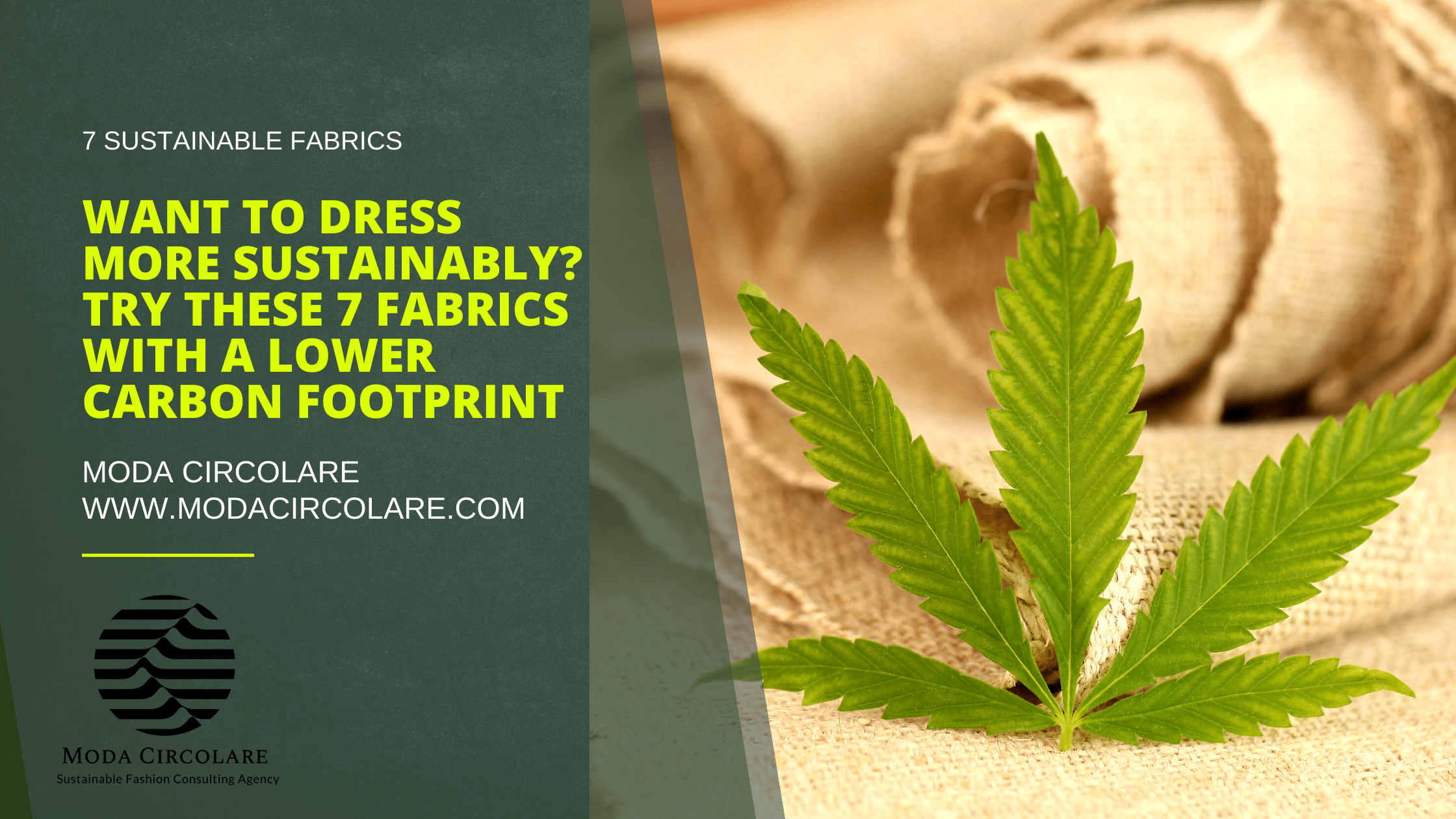
When thinking about what clothing you put on in the morning, do you ever give much thought to how much energy it took to make your clothes, or what clothing has the lowest carbon footprint? If you were like me, you likely never have.
Well, if you were like me, you likely didn’t even consider how much energy it took to make your clothing. It was only when I was taking a sustainability business class at Harvard, that someone mentioned that clothing was the elephant in the room that no one speaks about or thinks about. I had never thought about the amount of energy it took to make my clothes until that exact moment. Then a light went off in my head. I started doing research on the topic and my passion for this topic exploded. It is exploded so much so, that I started my own sustainable fashion consulting agency called MODA CIRCOLARE. We coach small apparel brands about the importance of sustainable fashion, how to reduce the amount of waste they create, how to improve their recycling rates and how to reduce their energy use. We also coach brands about utilizing fabrics with a lower carbon footprint.
In this article you will learn about 7 fabrics with a lower carbon footprint, what greenhouse gases are and where the energy is utilized in the apparel industry that causes all the CO2 emissions. At the end of the article you will find a list of what the most sustainable with the smallest carbon footprint.
The fashion industry
The environmental impacts involved in the manufacture of clothing can vary substantially from fabric to fabric. For example, when cotton is grown it can use significant water and heavy fertiliser, pesticide and herbicide use. However, the production of synthetic fibres involves the generation of GHG emissions from the processing of fossil fuels. For all fibres the dyeing and finishing processes can involve heavy water use resulting in hazardous waste from chemicals used in pre-treatment. The consumer use phase uses a lot of energy as well. This is from washing the clothes (hot water heating) and drying the clothes during use. All these processes contribute to significant environmental impacts.
According to Statista, the global apparel market is projected to grow in value from 1.5 trillion U.S. dollars in 2020 to about 2.25 trillion dollars by 2025, showing that the demand for clothing and shoes is on the rise across the world (8). This shows that even though we are trying to be more sustainable in our everyday lives, people are still going to be purchasing clothing and A LOT of it! So at least this article will give you the tools to make some better choices as it pertains to clothing.
The textile industry is identified as one of the largest producers of GHG all over the world. Kissinger et al. reported that textiles and aluminum generate the highest GHG emission per unit of material (3). The textile industry is indicated as the fifth largest contributor of CO2 emission. According to the European Parliament, the clothing and footwear industry produces 10% of all the GHG emissions in the world.
According to the Apparel Impact Institute and the World Resource Institute, current emission of CO2 by the apparel sector are estimated to be at 1.025 gigatonnes (Gt) of carbon dioxide equivalent but will rise to 1.588 Gt by 2030.
So that is a huge increase in the next 5 years if we keep consuming copious amounts of clothing. However there is something you can do about it. Keep reading!
Choose your wardrobe like you choose your diet
So in a nutshell, choosing the right fabrics for the clothing you wear can make a big difference. You know how people choose to be vegetarian or vegan instead of eating meat to reduce their carbon footprint, well this is basically very similar. Let me explain. Every single type of fabric has its own carbon footprint and there are huge differences among the various fabrics out there. Some synthetic fabrics, like nylon, polyester and acrylic, are made from petroleum based materials / fossil fuels and take a lot of energy to make and have a huge carbon footprint. Fabrics with a lower carbon footprint are the most sustainable way to go.
Synthetic (man-made) vs. Natural Fabrics
According to Research Gate, and the publication – Carbon Footprint of Textile and Clothing Products, 2015, the extraction of oil from the earth and the production of synthetic polymers require a high amount of energy and therefore emit a much higher amount of CO2 as compared to natural fibers (1).
Below are some diagrams that show the supply chain of both a natural and synthetic fabric and where energy is used and CO2 is emitted. These are from the BSR Apparel Supply Chain Carbon Report (9).
All of these parts of the value chain take energy and thus create CO2 emissions.

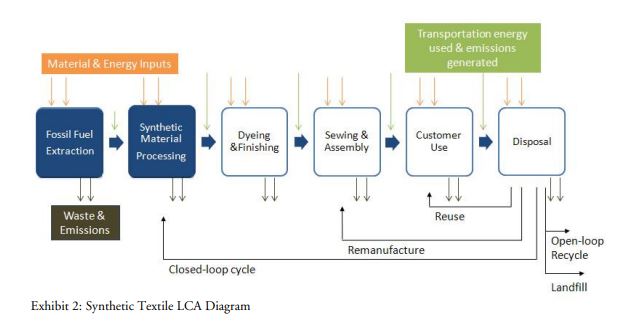
Carbon footprint definition
Carbon footprint is technically defined as – “the amount of carbon dioxide and other carbon compounds emitted due to the consumption of fossil fuels by a particular person, group, etc.” So when you are talking “carbon footprint”, you are talking CO2 and other green house gases. So what are they. Here is the list.
There are six different types of gases present in the atmosphere giving significant impact on the
greenhouse effect:
• Carbon dioxide (CO2)
• Methane (CH4)
• Nitrous oxide (N2O)
• Hydrofluorocarbons (HFCs)
• Perfluorocarbons (PFCs)
• Sulfur hexafluoride (SF6)
Carbon footprints are typically calculated to include all green house gases and are expressed as CO2 equivalent measured in kilograms or tonnes. As greenhouse gases produced by human activities accumulate and their concentration increases in the atmosphere, it causes global warming. The main contributor to global warming is carbon dioxide, which accounts for nearly 80 per cent of emissions from the industrialised countries (6).
Issues with synthetic man-made fibers vs. natural fibers
Synthetic fibers
Synthetic fibers are made from fossil fuels. Acrylic fiber requires 30% more energy during its production than polyester and for nylon it is even higher. Not only the quantity of GHG emissions is of prime concern for synthetic fibers, but also the type of GHGs produced is important. Nylon, for example, emits N2O, which is 300 times more damaging than CO2 and because of its long life, it can reach and diminish the layer of stratospheric ozone (1). In addition to energy use during production, synthetic fiber can shed microplastics into the water when you wash a synthetic piece of clothing. Synthetic fibers do not decompose: in landfills they release heavy metals and other additives into soil and groundwater. (4).
Natural fibers
Natural fibers, in addition to having a smaller carbon footprint have many additional benefits including being able to be degraded by micro-organisms and composted (improving soil structure); in this way the fixed CO2 in the fiber will be released and the cycle closed. (4).
Further, based on the study done by the Stockholm Environment Institute on behalf of the Bio Regional Development Group (2), the energy used (and therefore the CO2 emitted) to create 1 ton of spun fiber is much higher for synthetics than for cotton:
See below.
Fiber Kg CO2 /Ton of fiber
Polyester 9.52
Cotton- conventional 5.89
Cotton – Organic 3.75
Below you can see that various fibers have differing environmental impacts including energy consumption and greenhouse gas emissions. This table is from a study called, The role and business case for exiting and merging fibres in sustainable clothing (11).
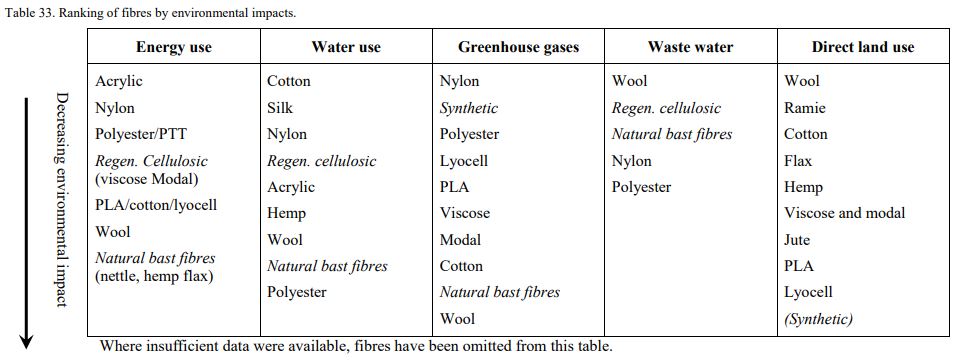
Different fibers have different CO2 emissions
In this Research Gate, and the publication – Carbon Footprint of Textile and Clothing Products, 2015, you can see that various fibers have different energy consumption and CO2 emissions. This makes it fairly obvious that synthetic fibres such as nylon, acrylic and polyester have the largest CO2 emissions. Fabrics with a lower carbon footprint are more sustainable.
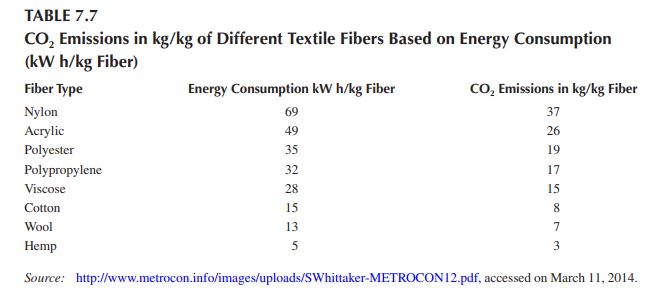
So how do you evaluate the carbon footprint of a fabric?
According to Fibre2Fashion (4), The carbon footprint of the textiles is estimated based on the embodied energy in the fabric, comprising all of the energy used at each step of the process needed to create that fabric. To estimate the embodied energy in any fabric it’s necessary to add all the process steps from fiber to finished goods. You must also consider whether the fabric is natural or synthetic (man-made).
For natural fibers you must look at field preparation, planting and field operations (mechanized irrigation, weed control, pest control and fertilizers (manure vs. synthetic chemicals), harvesting and yields. Synthetic fertilizer use is a major component of the high cost of conventional agriculture: making just one ton of nitrogen fertilizer emits nearly 7 tons of CO2 equivalent greenhouse gases.
For synthetics, a crucial fact is that the fibers are made from fossil fuels. Very high amounts of energy are used in extracting the oil from the ground as well as in the production of the polymers. According to a study done by SEI, polyester production emits the greatest CO2 emissions, ranging from 7.2 to 9.52kg of CO2per tonne of fibre. Again, CO2 emissions associated with cotton range widely from 2.35 to 5.89 kg of CO2 per tonne of fibre (2).
The CO2 emissions associated with the production of one tonne of spun fibre are closely linked to the energy requirements of producing that fibre (2). The graph below from SEI shows not only the difference in fibres, but also in crop cultivation and fibre production. It is obvious from the graph below that polyester in this study had the highest carbon dioxide emissions for fibre production and crop cultivation.
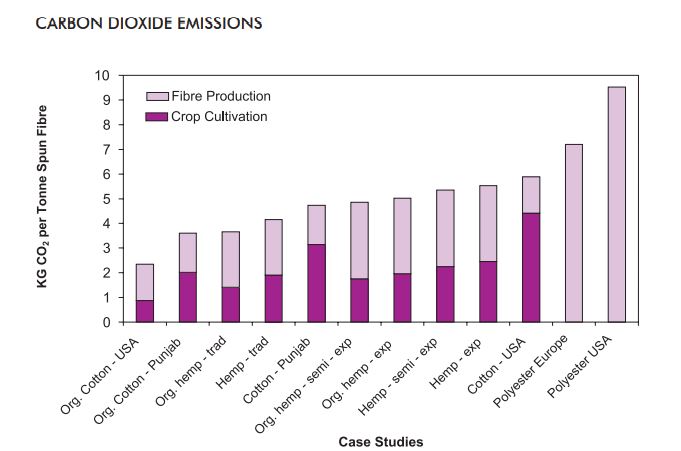
Below is another table that shows the various energy use in the areas of raw material production, fibre production, fabric production, preparation, dyeing and finishing. As you can see, for cumulative energy acrylic was rated as high and so is nylon. The lowest scores overall went to hemp, linen, nettle and wool.


Where is all the energy used?
According to Research Gate (1), electrical energy is one of the major energy consumption sectors in the textile industry, and electrical energy is spent for driving machinery, cooling, temperature control, lighting, and office equipment. Among the various textile industries, the spinning industry takes the major share of electricity with 41%, followed by weaving and wet processing units. The emission of CO2 in case of natural fiber production occurs during preparation, planting, field operations (weed control, mechanical irrigation, pest control, and fertilizers), harvesting, and yields. However, energy used and CO2 emitted to manufacture 1 ton of natural fiber are much lower as compared to synthetics fibers. In case of cotton textiles, 50% of CO2 emissions occur during fiber production, manufacture, trade, and transport and the remaining 50% are caused by daily usage, that is, washing and drying. Textile finishing is an important process for cotton textiles leading to significant amount of carbon footprint resulted from CO2 emissions of 40% from washing and steaming, 50% from drying, and 10% from the use of chemicals (1).
So what are the 7 fabrics fabrics with a lower carbon footprint?
The 7 most sustainable fabrics with a lower carbon footprint are:
- Organic Cotton
- Hemp
- Linen
- Nettle
- Wool
- Lyocell
- Modal
Virgin polyester is quite energy intensive, however, if you choose recycled polyester, this is an acceptable option. Fabric manufacturers can use PET bottles, clothes, and fiber waste to make recycled polyester. I understand these fabrics still create microplastics, however, we have a bunch of polyester on our earth, so we should keep it circulating if possible. This way, we need to create less and just re-use what is already have on our planet.
Here is a fun shopping list of sustainable fabrics. It also outlines the ones to avoid.
Key Take-aways
I. Calculating the energy and CO2 footprints of different types of fabrics is complicated. There are so many different studies that have been done. What makes it difficult is what parts of the process have been considered in the calculations.
2. Stick with natural fibers, if possible. Hemp, Linen etc.
3. Choose organic fabrics whenever possible.
4. Avoid virgin synthetic fabrics (polyester, acrylic, nylon etc.) as these are make from fossil fuels.
5. If you choose polyester, choose polyester from recycled sources (from waste fabric or bottles)
6. Head to the thrift store to purchase used clothing or if you are a brand, use off-cuts and deadstock into your designs.
Looking to improve your sustainability performance? Read our blog here.
About the Author:

Lizzy Cross is the founder and CEO of MODA CIRCOLARE, a sustainable fashion consulting agency. Lizzy has over 15 years of experience in sustainability and environmental risk. She is a sustainability fashion expert and coach and helps fashion and apparel brands all over the world to embed sustainability and circularity into their business strategies. Lizzy has a master’s degree in Bio-Resource / Environmental Engineering and has taken Sustainable Business Strategy at Harvard Business School. Read more about sustainable fashion @modacircolare and at www.modacircolare.com
Any questions? We are here to help!
Error: Contact form not found.
References
(1) (PDF) Carbon Footprint of Textile and Clothing Products (researchgate.net)
(2) Ecological footprint and water analysis of cotton, hemp and polyester – SEI
(3) Kissinger M, Sussmann C, Moore J et al. Accounting for greenhouse gas emissions of materials
at the urban scale-relating existing process life cycle assessment studies to urban material and waste composition. Low Carbon Econ 4 (2013): 36–44.
(5) The Conscious Club – Energy and Clothing
(6) Dev, Vivek, “Carbon Footprint of Textiles”, April 3, 2009, http://www.domain-b.com/environment/20090403_carbon_footprint.html
(7) European Parliament – The impact of textile production and waste on the environment. 2020
(8) Statista – The Global Apparel Market, Stats and Figures 2022
(9) BSR – Apparel Supply Chain Carbon Report
(10) Good On You – How ethical is Tencel
